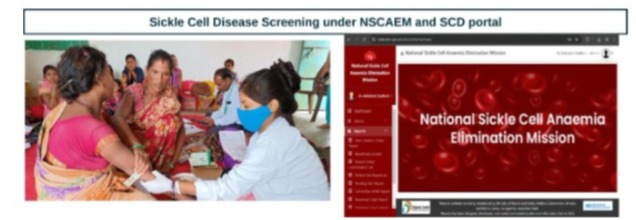National Sickle Cell Anaemia Elimination Mission was launched under the visionary leadership of the Hon’ble Prime Minister. This groundbreaking initiative seeks to not only eliminate sickle cell genetic transmission but also restore dignity and health to millions affected by this condition.
India’s tribal communities represent the soul of the nation’s cultural tapestry, constituting 8.6% of the population. Yet, many within these communities have been silently battling the debilitating genetic disorder known as Sickle Cell Disease (SCD). For decades, this condition has taken a toll on their health and socioeconomic development, exacerbated further by geographic isolation and limited access to healthcare. Recognizing this dire need, Government of India, launched the National Sickle Cell Anaemia Elimination Mission (NSCAEM) in July 2023 under the visionary leadership of the Hon’ble Prime Minister. This groundbreaking initiative seeks to not only eliminate sickle cell genetic transmission but also restore dignity and health to millions affected by this condition.
Sickle cell disease alters the shape of red blood cells, impairing their oxygen-carrying capacity and leading to severe health complications over time. Among tribal populations, the impact is profound, as they are disproportionately affected by this genetic disorder. According to “Global Burden of Disease estimates (2021)”, an estimated 82,500 births, with SCD occur in India.
The National Health Policy 2017 laid the groundwork for addressing this crisis, emphasizing its unique health needs. Building on this, the Union Budget 2023 announced the NSCAEM, setting a target to screen 7 crore individuals under 40 years by FY 2025-2026, in a mission mode. The activity was implemented under the Ministry of Health and Family Welfare (MoHFW), making it one of the largest population-based genetic screening programs globally. The mission also aims to eliminate genetic transmission of SCD by 2047 while providing comprehensive care to those already afflicted.
In its first two years, this mission, has yielded remarkable results, with joint efforts of Ministry of Health and states. As on 31st July 2025, over 6.07 crore individuals have been screened across more than 300 districts in 17 high-prevalence states. Among those screened, 2.16 lakh individuals were found to be diseased, while 16.92 lakh were identified as carriers. Analysis reveals that 95% of cases are concentrated in five states i.e. Odisha, Madhya Pradesh, Gujarat, Chhattisgarh, and Maharashtra.
The story of Meena, a young tribal girl from Nawapara Ambikapur, Chhattisgarh, is emblematic of the mission’s impact. Diagnosed during the screening drive, Meena was enrolled in a nearby Sub-health Centre. The trained Community Health Officer (CHO), ANM and ASHA at the SHC ensured that she had access to free hydroxyurea drug which significantly alleviated the symptoms of SCD. Today, Meena leads a healthier life and is an advocate for genetic counselling in her community.
To accelerate screening efforts, Point-of-Care (PoC) diagnostic devices approved by the Indian Council of Medical Research (ICMR) have been deployed. Initially limited to three, the number of approved kits has now
expanded to over 30, reducing costs dramatically from ₹100 to ₹28 per kit. This initiative has ensured cost-effective and efficient diagnostic capabilities, for SCD.
Implementation of this mission, under the Ministry of Health, is not solely focused on screening; it prioritizes holistic care for individuals diagnosed with SCD. Management interventions under the mission include free healthcare services, with access to essential medicines and diagnostics Hydroxyurea, a key drug for managing SCD, is added to the National Essential Drug list (EDL) and is now available till Sub-health Centres Ayushman Arogya Mandirs (SHC-AAM), ensuring accessibility till last mile.
The mission also emphasizes genetic counselling and public awareness as pivotal strategies for eliminating SCD. Over 2.62 crore genetic status cards have been distributed, empowering individuals with critical health information. SCD cards have become a vital tool for counselling and informed decision-making, enabling families to make choices that reduce the risk of genetic transmission.
Fifteen Health care institutions/medical colleges have been selected to establish Centres of Excellence (CoEs), as per guidelines laid down by the Ministry of Health and Family welfare (MoHFW), and funding support from Ministry of Tribal Affairs (MoTA). These institutions focus on prenatal diagnosis and management of severe SCD complications, ensuring specialized care for at-risk families. Additionally, a National Level Training of Trainers (ToT) program organized in October 2024 has equipped healthcare professionals with the skills and knowledge needed to address the complexities of SCD management effectively.
The success of NSCAEM is underpinned by the “Whole-of-Government” approach, by which Ministry of Health is involving the Ministry of Tribal Affairs, Ministry of Social Justice & Empowerment, Ministry of Education, and Ministry of Women and Child Development. This inter-ministerial coordination ensures holistic implementation, addressing the socio- cultural and geographic dimensions of tribal health. Research-backed interventions, supported by the Department of Health Research, under the MoHFW, has further enhanced cost-effectiveness and patient outcomes.
While the achievements, are commendable, the Ministry of Health, has now shifted focus on future priorities for the mission. The immediate focus will be on expanding genetic counselling, public awareness campaigns, and distribution of genetic status cards. Leveraging community-level platforms will be crucial in ensuring that every carrier and diseased individual receives the care and support they need. Enhanced research efforts will provide actionable insights to refine interventions further.
The true spirit of this mission lies in its motto: “Supporting our fighters, strengthening our survivors, and standing by our warriors.” By combining
political will, scientific innovation, and grassroots implementation, India is poised to eliminate sickle cell anaemia and transform the lives of millions.
As India strides confidently towards its 2047 goal of eliminating SCD, the NSCAEM stands as a beacon of hope. It exemplifies what can be achieved when government, healthcare professionals, and communities unite for a common cause. Together, we will ensure that no individual, has to endure the pain and suffering caused by this condition.
India’s fight against sickle cell anaemia is not just about combating a genetic disorder—it is a commitment to equity, dignity, and the health of our nation’s most marginalized groups. With the experience of individuals like Meena guiding the way, the mission serves as a testament to the transformative power of targeted healthcare initiatives, marking a historic leap in addressing tribal health challenges.
Let us celebrate this groundbreaking effort and reaffirm our resolve to build a healthier, more inclusive India
Courtesy PIB, Srinagar
The writer is Union Minister of Health & Family Welfare






